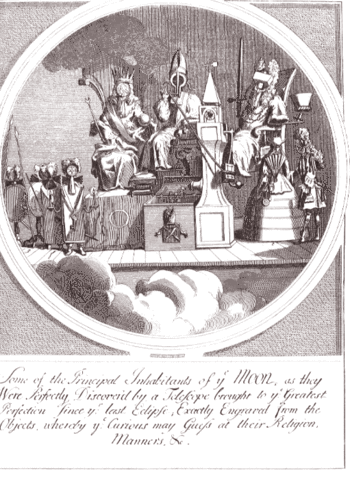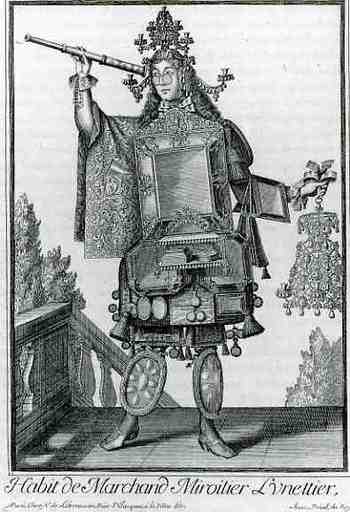JF Ptak Science Books LLC Post 183
In what seems to be a continuing post on the idea of blank people (I’ve posted on them twice before, here and here), that is to say, images of people with almost no attributes, people waiting to be “drawn in” or “filled up”, or completed in some way. The image that I saved today is from William Hogarth, whose witty attempt in displaying the hoaxing reports of life on the Moon depicts empty Moonpeople, "revealed during an eclipse, thanks to a powerful telescope, and faithfully reproduced afterwards". Machines and instruments during this time seemed to have improved much quicker than the fictional and fantastical thinking that may have used them--even so Umberto Eco, who I think misses this point, wrote that, in this particular case, the telescope "had not pout an end to fantasy....but it has often deprived it of discernment and moral commitment, reducing it to an ingenious and neurotic form of futuristic anticipation". (This is From Eco's first book, printed in 1963 (!), The Picture History of Invention, written with G.B. Zorzoli. In spite of its tragic title, the writing and appreciation of invention is very good.)
In a great prank/hoax of the 19th century, it was reported in 1835 that Sir John Herschel (son of a hugely important astronomer, Sir William, and who was of great importance in his own removed right) found some sort of living, humanoid-like beings alive, and seemingly thriving, on the Moon. He did this with a 24-foot (diameter!!) telescope that “cost three hundred thousand dollars”, an amount funded by the King. The whole thing was moved to the observatory at the Cape of Good Hope, where the discoveries were made. Sir John was of course quite surprised to hear of his discoveries, though I'm sure he would’ve been happy to get his hands on the telescope, which would’ve been the largest in the world, by far, in 1835. John's father, the extraordinary Sir William Herschel, owned one of the world's largest in the 18th century. It was 48" in diameter, and a monster for its time. As a matter of fact in the first month or so of the announcement of the invention of photography John built his own camera and made a daguerreotype of his father's instrument. In one of the few true bits of the story, John Herschel's telescope was famously located at the Cape of Good Hope (John having moved his family and his 20' scope their in 1833).
The imaginary telescope wouldn’t be the largest in the world, now, though—the Keck instruments in Hawaii (at 10 meters) and the Gran Telescopio Canarias (10.4 meters in the Canaries) would dwarf the unimaginably huge fictional creation of 1835. The extraordinary price, too-an unreachable amount, actually, in 1835—would’ve been about a huge amount today as well: the adjusted for CPI figure for $3000,000 1835 dollars would be around $7 billion 2008 dollars. A lot, of course, but not an order of magnitude more, I think, than the cost of these things, and certainly not an impossible-to-imagine amount as the Sir John fictional scope. (It seems to me that the Anglo-Australian telescope named for John Herschel with first light in 1987 cost 25 millions dollars.)
On a different route altogether is the Mirror Man, who in some aspects is a blank person because he mirrors everything that is placed before him, a parable-like tabula rasa, writ on again and again. (The legend reads “Habit de Marchland Miroitier Lunettier” by Nicolas de Larmessin III (1640-1725). (This image was surfaced in Barbara Stafford and Frances Terpak’s Devices of Wonder, from the World in a Box to Images on a Screen, The Getty, 2002, page 258.) The history of the mirror is really pretty interesting, and even by the time that this engraving was made the mirror was still an uncommon object--more so in the hands of the common folk. (I wonder when it was that the majority of the working classes in the United States were able to have a good, long look at themselves in their own mirror at home? When did most people in the U.S. have the luxury of being able to see themselves, in private, whenever they wanted too? Like, when could they look at their own teeth in private? Or see themselves naked? My guess is that it is between 1800-1850.)



Speaking of blank people, let's not forget The Far Side's take on G-Dub-the-Shrub.
Posted by: anomalous4 | 29 July 2008 at 03:03 PM